Borrego Springs in the Anza-Borrego Desert is one of Marlene's and my favorite winter and spring getaways in San Diego County. We had planned to take some non-birding friends and get a motel and spend the whole weekend. However, it was a "super bloom" of wildflowers following this winter's exceptional rains. Motels were filled "every day in March." Bummer. We checked again a few days before our trip. They had a cancellation. Yay! $250. Double the usual rate? Yeah, right. I mean, it's only a 90-minute drive from our own comfortable bed. We could spend that money on many other pleasant things. So, a day trip it was.
My previous post was about the
amazing wildflowers. Now I retell the same story of the same day, but this time with birds as the protagonist.
We arrived just before dawn. I decided to check out Old Springs Road Open Space Preserve--a place where I had seen wildflowers in the past. It also happens to be one of the only places in the county with Le Conte's Thrashers--a robin-sized secretive ground bird of barren sand dunes and widely scattered bushes.
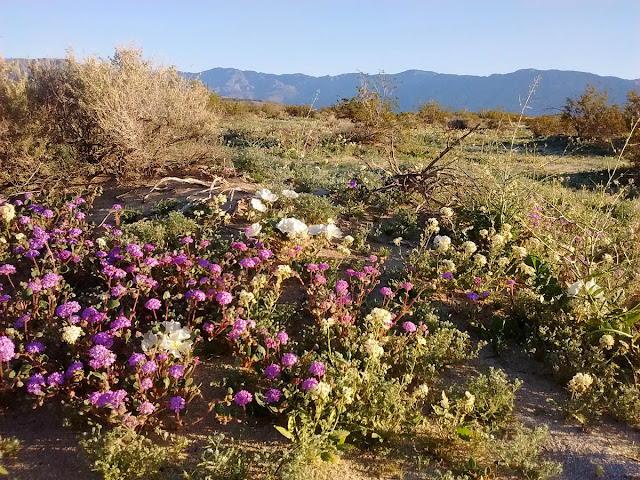 |
| A carpeting of wildflowers on the dune sands at Old Springs Road OSP, Borrego Springs, California. |
After photographing lots of flowers, I finally heard some faint thrasher song and thought it sounded like Le Conte's. It was hard to pinpoint the direction the birdsong was coming from as the landscape here makes a natural amphitheater and the highway traffic a half mile away sounds like jet aircraft taking off. Eventually the singing picked up, then was coming from multiple directions. But not from the sparsely vegetated dunes to the east where the Le Conte's Thrasher should be. No, the songs came from the dense sage flats to the west of the road. And that means...yup, straighter bill and breast spots--Sage Thrashers. Sage Thrashers are regular rare winter desert visitors and early spring migrants. Always a nice find, but not as local and hard-to-find as the resident Le Conte's Thrasher.
 |
| Sage Thrasher is always a nice consolation prize when you don't find the Le Conte's Thrasher. |
After some time here with only a few skittish Brewer's Sparrows and a fly-over Common Raven we moved on.
One of our goals for this trip was to see part of the annual Swainson's Hawk migration as they gather to feed on the sphinx moth caterpillars which were, in turn, feeding on the wildflowers. These primarily grasshopper-eating hawks migrate thousands of miles from the wintering grounds on the Pampas of Argentina to the native prairie grasslands of the western North America where they breed. I'm beginning to understand the movement through this area a bit better now, I think. For 6-7 weeks from late February to mid April, a few to a hundred or more hawks arrive in the Borrego Springs date farms each evening to roost. They feed on caterpillars in the fields of wildflowers at dawn, then gather in a huge swirling mob ("kettle") in the thermals before leaving the valley to continue their migration. [I wrote about this migration 2 years ago,
here.] Well, the flowers had only been out a week. I guess that wasn't enough time for the caterpillars to hatch out and start eating. So, no caterpillars meant no hawks feeding on the ground in the morning. In a week or two it should be better.
Marlene and I stopped by one of the hawkwatch sites (mounds) on the side of the road where volunteers and interested birders gathered to yack about birds and watch for the Swainson's Hawks to lift off. I hoped to find birds roosting or feeding on the ground to photograph at closer range. I was told of a nearby road to walk down and try.
 |
| Hawk watchers scan for Swainson's Hawks. |
Well, the first hawks I spotted at 10:30 am weren't on the ground feeding. They were already gathering in flight getting ready to leave. I counted 55 birds in three kettles. The two
hawkwatch sites tallied over 200 hawks migrating out of the Borrego Valley this morning.
 |
| Distant specks are Swainson's Hawks grabbing a thermal to help them soar away on their northward migration. |
I spotted a few other birds while at this location.
 |
| A pair of California Quail |
 |
| Greater Roadrunner crossing the road |
 |
| X marks the spot--roadrunner tracks! Weird toes of the cuckoo family, |
Well, not much happening here. Breakfast? Or birding out at the waster treatment ponds? Okay, let's try the ponds. Maybe I can spy a Crissal Thrasher in the mesquite trees--another rare resident found in the county only in this tiny area.
Well, wouldn't you know it. On the busiest tourist day of the year, a few locals decided to go to a public area and set up target practice. Bad enough. But the buzzing throb of ricocheting bullets overhead were enough to make me give up after a few minutes. I did manage to hear a Sora rail calling from the tall wet grass in the pond. I managed one picture:
 |
| Zebra-tailed Lizard |
Well, I also got a phone shot of the habitat--greener than usual, but not many flowers at all compared to a couple of miles away.
 |
| Green, but flowerless desert near Borrego Springs waste treatment ponds. |
Chased away by gun fire, struck out three times with target birds, and hungry. Marlene and I made our way to a welcome breakfast at Kendall's Café. We didn't even have to wait long! [I heard later that many of the restaurants were running out of food. And there weren't enough public restrooms in town to accommodate the number of wildflower visitors!]
After breakfast, and closing fast on noon, it was quite warm. With all the traffic and visitors we went to a location we knew wouldn't be crowded. We drove through the private country club called the Roadrunner Club. For the most part, we drove through the area slowly, using the car as a mobile photography blind.
This mobile home park and golf course is green with mature trees and landscaping and has many well-stocked bird feeders. We stopped at the entrance gate and I finally got a photo of two Inca Doves. Again, like the thrashers, the Anza-Borrego Desert is the western outpost for this species. I've visited the Roadrunner Club multiple times over the past 3 years and this was only the second time I've spotted this rare recent resident species.
Okay, more details. The official name is Roadrunner Golf & Country Club. Half is the mobile home park, and half is stick built homes on a more newly developed parcel (fewer trees and many sandy empty lots). Then this private residential area merges into an RV Park--The Springs at Borrego RV Resort. The golf course winds through them all with several ponds. Some of the homes are vacation rentals.
Notice I keep saying "private"? It is possible that the bird watching public could be turned away. So far this hasn't happened. The gates have always been opened and the "for sale" and "for rent" signs intimate that the public is expected to have some access. So view access as a precious and revocable privilege if you ever decide to visit. Drive slowly and be friendly and courteous to residents and staff.
So, now that I have that out of the way...
 |
| Inca Dove. My first photo ever of this species. |
 |
| Inca Dove. Note the scaled upper parts and long tail. |
 |
| Sparrow-sized Common Ground Doves. Note the short tails. |
Near a roadside pond I stopped to look carefully for any unusual ducks. While there a couple of Roadrunners came up and looked in my car window. Perhaps they were looking for handouts. Good thing they're only knee high. If they were 6 feet tall they'd give the velociraptors from Jurassic Park a run for their money! What great, zany birds!
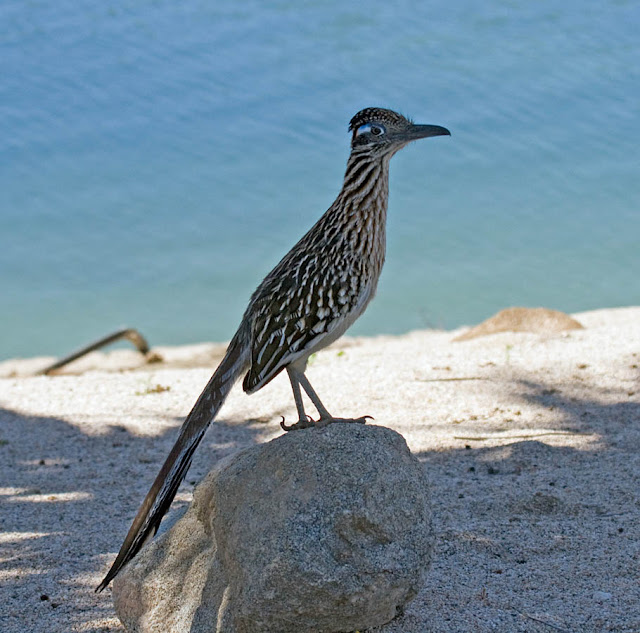 |
| Greater Roadrunner |
A pair of Wood Ducks has been present here for almost two years now. They are very rare in the Borrego Valley generally, though regular only 15 miles to the west up in the mountain lakes.
 |
Rare here, Wood Ducks swimming below a Mallard. A documentation photo.
(That's what you call it when it doesn't turn out very well, but you show it anyway.)
|
American Robins are regular on the golf course lawns in winter. At least two still remained. These late birds will probably fly west a short distance up into the mountain forests to breed. I could be wrong, but I assume birds breeding in the far north (like Alaska) have probably already migrated. A noticeable movement of robins passes through western Oregon in February, for instance.
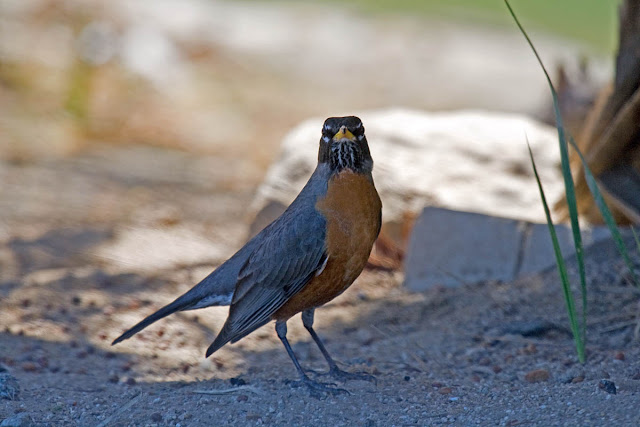 |
| American Robin. |
A well-stocked bird feeder with bird baths was our last stop. We spent almost 15 minutes here taking photos from our vehicle. The primary species was the desert resident White-winged Dove. It is a large and pleasant-looking pigeon. [There is actually no biological difference between birds named doves and birds named pigeons. Most "doves" are smaller, but as in the Eurasian Collared-Doves (above) you can see that it is not a firm rule.]
The song of the White-winged Dove is uncannily similar to that of the Barred Owl--an owl of SW swamps and northern forests. The song of both is a loud cooing "Who cooks for you?" It amuses me when I hear that Barred Owl-like call coming from the dry desert washes. It is a delightful surprise to the expectations of my brain to hear this incongruous sound.
 |
| White-winged Dove |
My final bird photo is that of the Verdin. It is a gray chickadee-like desert bird with a yellow head, and loud cheerful chirping call. In fact, it is probably the signature bird of the Anza-Borrego Desert. It is common in the desert, and strictly found only in the deserts of the American Southwest.
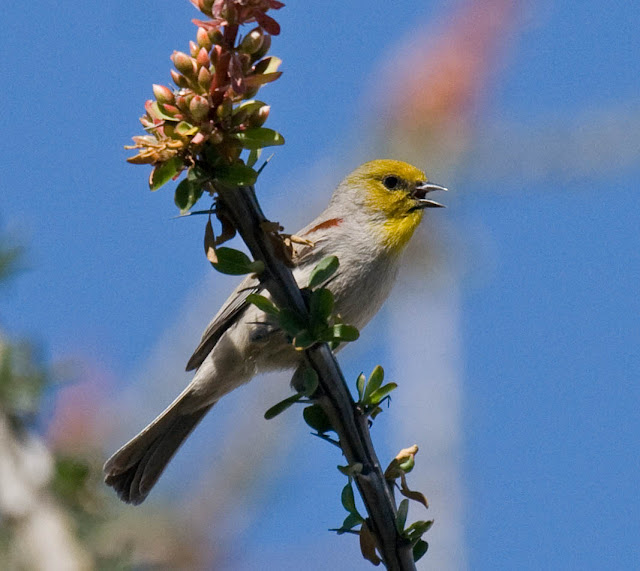 |
| Verdin |



















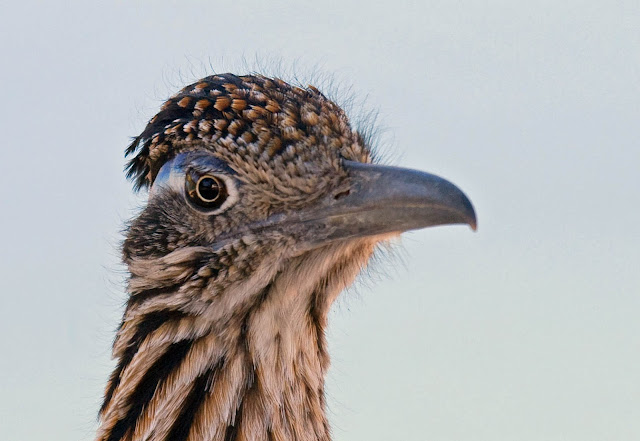







No comments:
Post a Comment
I really want to hear from you! I've changed settings (again) in order to try to make commenting easier without opening it up to spammers. Please note, however, that comments to posts older than 14 days will be moderated. Thank you.